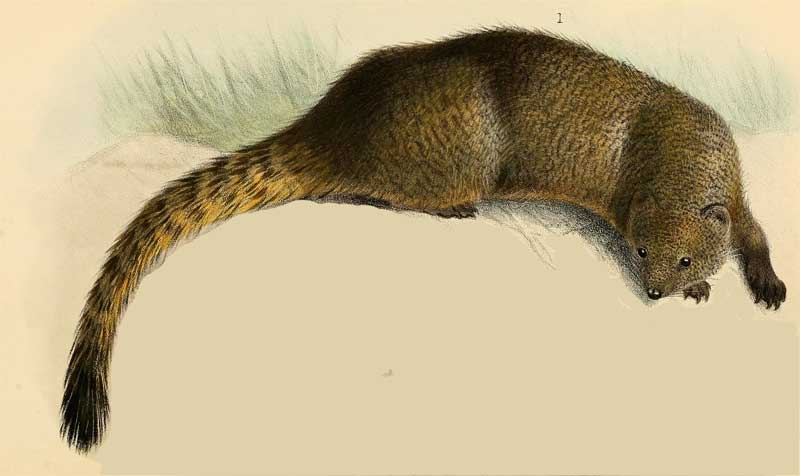
Galerella pulverulenta subsp. ruddi (Thomas, 1903)
Superregnum: Eukaryota
Cladus: Unikonta
Cladus: Opisthokonta
Cladus: Holozoa
Regnum: Animalia
Subregnum: Eumetazoa
Cladus: Bilateria
Cladus: Nephrozoa
Superphylum: Deuterostomia
Phylum: Chordata
Subphylum: Vertebrata
Infraphylum: Gnathostomata
Megaclassis: Osteichthyes
Cladus: Sarcopterygii
Cladus: Rhipidistia
Cladus: Tetrapodomorpha
Cladus: Eotetrapodiformes
Cladus: Elpistostegalia
Superclassis: Tetrapoda
Cladus: Reptiliomorpha
Cladus: Amniota
Cladus: Synapsida
Cladus: Eupelycosauria
Cladus: Sphenacodontia
Cladus: Sphenacodontoidea
Cladus: Therapsida
Cladus: Theriodontia
Subordo: Cynodontia
Infraordo: Eucynodontia
Cladus: Probainognathia
Cladus: Prozostrodontia
Cladus: Mammaliaformes
Classis: Mammalia
Subclassis: Trechnotheria
Infraclassis: Zatheria
Supercohors: Theria
Cohors: Eutheria
Infraclassis: Placentalia
Cladus: Boreoeutheria
Superordo: Laurasiatheria
Cladus: Ferae
Ordo: Carnivora
Subordo: Feliformia
Familia: Herpestidae
Subfamilia: Herpestinae
Genus: Galerella
Species: Galerella pulverulenta
Name
Galerella pulverulenta Wagner, 1839
References
Galerella pulverulenta in Mammal Species of the World.
Wilson, Don E. & Reeder, DeeAnn M. (Editors) 2005. Mammal Species of the World – A Taxonomic and Geographic Reference. Third edition. ISBN 0-8018-8221-4.
Vernacular names
Deutsch: Graue Kapmanguste
English: Cape Grey Mongoose
français: Galerella pulverulenta
italiano: Galerella pulverulenta
The Cape grey mongoose (Herpestes pulverulentus), also called the small grey mongoose, is a small mammal native to South Africa, Lesotho and southern Namibia.
Appearance
It is a small species (55–69 cm long, weight range 0.5 – 1.0 kg). It is a dark grey colour with a darker tip of the tail. The legs are a darker grey than the rest of the body. It has a typical elongated mongoose body-shape. The ears are small and rounded and are situated on the sides of the head. The tail is long and bushy. The teeth show adaptations for both cutting and crushing.
Diet and behaviour
The Cape grey mongoose feeds mostly on insects and small rodents, but will also eat birds, small reptiles, amphibians, other invertebrates, and fruit. They have been known to eat carrion and garbage as well.
It is predominantly insectivorous but also carnivorous. Insects and other arthropoda such as spiders are caught on the ground and then held down with the forefeet and eaten. Larger prey such as rodents are stalked and killed with a bite to the head. Large prey items are held down with the forefeet and then torn into bite size pieces with the teeth.
Small rodents, in particular Otomys and Rhabdomys, are their most important dietary component. On occasion, immature hares or the young of small antelopes such as Cape grysbok may be attacked.[2]
Distribution
Until a few decades ago, the species was thought to be endemic to the Cape Province, but it is now known to occur in much of the rest of South Africa and in the west, northwards to southern Angola. It is not yet clear how continuous the range is, nor how much of this wider presence is due to extension of its range. Its density in areas where the species is established, ranges from one mongoose per 60 hectares to one per two hectares.[2]
Habitat
It inhabits macchia-type vegetation (fynbos), semi-desert scrub (Karoo), thicket and forest. However, it is not found in the grassland biome. Often they live in close association with man, often under the floors of outbuildings, and even live successfully on the fringe of suburbia. When habituated to human presence, they may tolerate close approach.[2]
Behaviour
Cape gray mongoose, late adolescent, member of a family party, inspecting surroundings.
The Cape grey mongoose is diurnal. When not breeding, it is solitary, but litter remains together in a family party at least until late adolescence. They live in overlapping home ranges of 5-68 ha, with the males having larger ranges than the females. However, it is not entirely clear whether this species is territorial or not, or whether it might be more social than generally believed. They are poor diggers so they utilize piles of rocks, crevices, deserted burrows and hollows in tree trunks for shelter when there is not sufficient bush cover. They are often spotted by humans when they cross roads.
Reproduction
Litters of 1 – 3 young are born from August to December and are hidden in burrows, rock crevices or tree hollows. At birth, the pups are fully furred but their eyes and ears are closed, only opening after about a fortnight. The young remain in the breeding burrow until they are fully weaned, and leave when they are capable of independence.
References
Do Linh San, E.; Cavallini, P. (2015). "Herpestes pulverulentus". IUCN Red List of Threatened Species. 2015: e.T41600A45205999. Retrieved 19 November 2021.
Mills, Gus; Hes, Lex (1997). The Complete Book of Southern African Mammals. Cape Town: Struik Publishers. ISBN 0947430555.
Retrieved from "http://en.wikipedia.org/"
All text is available under the terms of the GNU Free Documentation License

